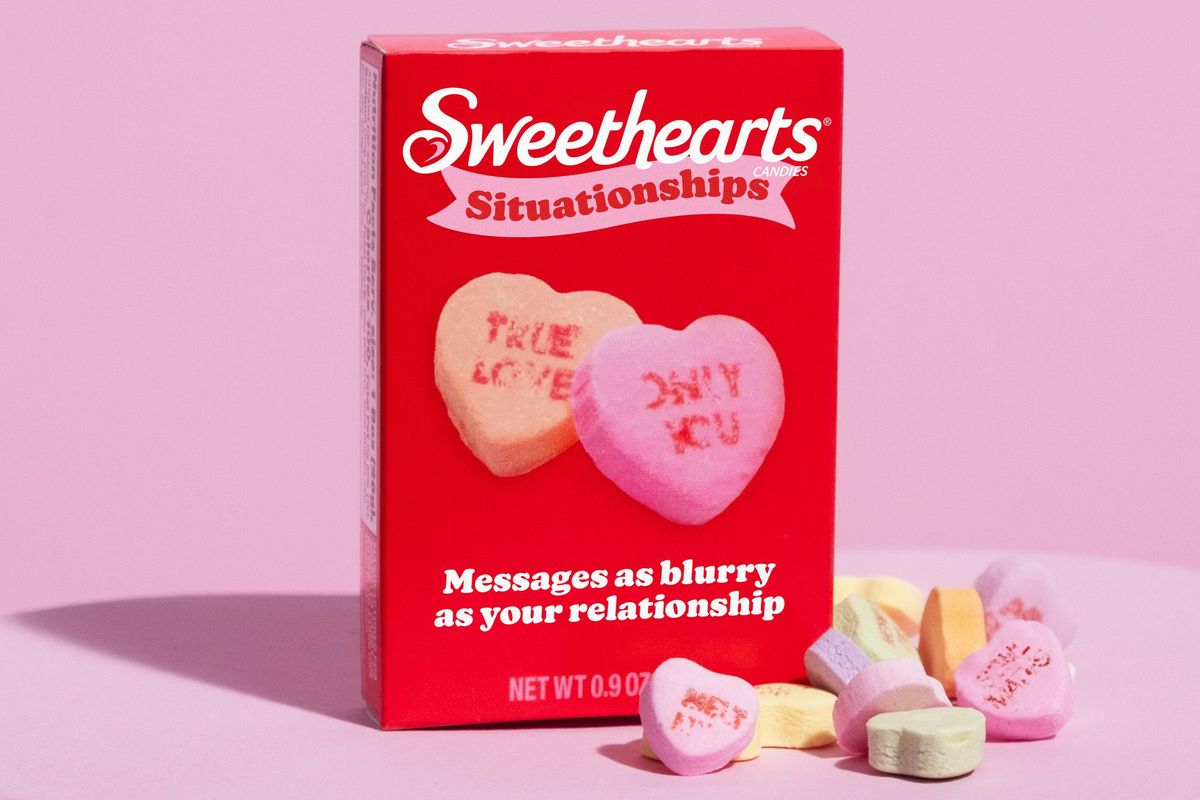Sweethearts adds 'situationships' to their iconic conversation hearts Valentine candies
"Messages as blurry as your relationship."

Sweethearts includes 'situationships' in iconic candy hearts
Single-dom is in the air this coming Valentine's Day. Maybe not completely single but also not in a relationship. You know, the whole thing is complicated. A lot of younger Millennials and Gen Zers are just not interested in being in full-blown relationships, but that doesn't mean they don't enjoy companionship with someone that has similar interests.
Every relationship that blurs the line between friendship and dating is different, but they all have one thing in common–they're not dating. The concept of a "situationship" isn't new, but they are more common with younger generations. What is new is that fuzzy undefined relationship being recognized by the iconic Valentine candy maker, Spangler Candy Company, who has made conversation candy hearts for more than 150 years.
Those candy hearts are easily recognizable and always say something sweet like, "LOVE YOU" or "KISS ME" written in all caps.
"Singles are taking 'situationships' to the next level this year, and Sweethearts is here for them," Evan Brock, vice president of marketing for Spangler says in a press release. "The printing on Sweethearts isn't always perfect. This is our way of embracing those imperfections in a way that taps into pop culture."
Being in a situationship isn't always fun for those involved in one. There are mixed reports on if situationships are harmful, with some professionals putting out tips on how to avoid them, which makes one wonder—why are they so popular?
The Bay Area CBT Center writes, "Situationships, with their vague boundaries and undefined statuses, often captivate individuals due to a psychological phenomenon known as intermittent reinforcement. Intermittent reinforcement occurs when desired behaviors are rewarded or reinforced sporadically rather than consistently. This unpredictability in the delivery of rewards or positive outcomes makes the behavior more resistant to extinction."

Sweethearts Conversation Hearts
Photo by Laura Ockel on UnsplashBut these situationships also fulfill a need or else they wouldn't be so prevalent. Elizabeth Armstrong, a sociology professor at the University of Michigan tells the BBC, “Right now, this solves some kind of need for sex, intimacy, companionship – whatever it is – but this does not have necessarily a long-term time horizon.”
Either way, it doesn't seem like young adults are opting out of these types of relationships anytime soon, so marketing to that growing sector makes sense. Conversation hearts have been a staple candy for quite literally over a century, filling Valentine's boxes at school and helping with marriage proposals.
It's America's favorite chalky seasonal candy and they're including a demographic that may have otherwise opted out of Valentine's gifts in an effort to not make things awkward. Now, you can fill a basket with whatever goodies you want with these situationship candies on full display so there's no confusion with the undefined lines of the non-relationship relationship.
The Sweethearts will be blurry and misprinted to go with the theme of situationships and only available for a limited time started January 8th at 9 a.m., according to the press release. But they won't be sold in stores, so if you've got a blurry sweetheart in your life you'll want to run over to SweetheartsCandies.com to order a box before they're gone.





 Rihanna Nails GIF
Rihanna Nails GIF Good luck trying to catch a gazelle.
Good luck trying to catch a gazelle. Chickens will eat just about anything.
Chickens will eat just about anything. There's actually a big difference between horses and zebras besides just the stripes.
There's actually a big difference between horses and zebras besides just the stripes. People used to have actual maps in their cars.
Photo by
People used to have actual maps in their cars.
Photo by  We used to literally chart out long road trips on a physical map before departing.
We used to literally chart out long road trips on a physical map before departing. Google Maps shows crucial information about natural disasters like wildfires
Google Maps shows crucial information about natural disasters like wildfires Jeff Bezos unveils Blue Origin's prototype lunar lander in 2019.via
Jeff Bezos unveils Blue Origin's prototype lunar lander in 2019.via